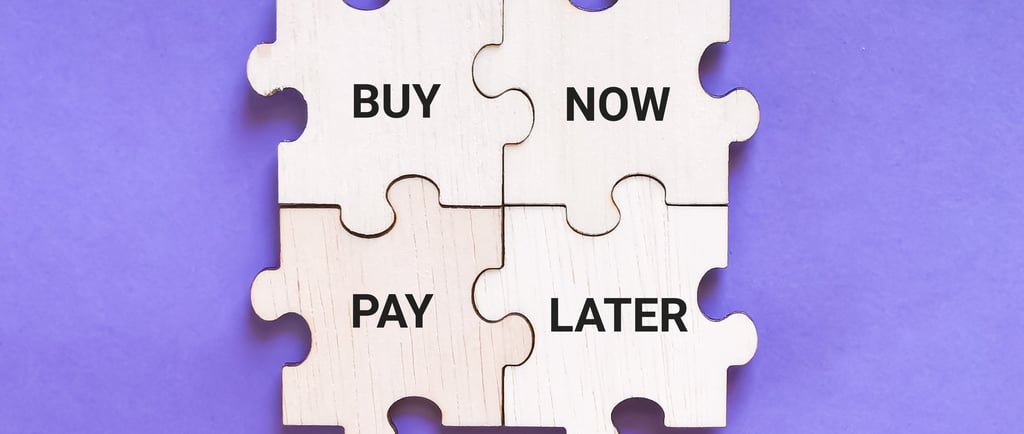Buy Now, Pay Later: When It’s Smart—and When It’s a Risk
A smart tool for budgeting when used wisely—BNPL can also become a silent debt trap if misused.
Finistack
6/1/20253 min read


Buy Now, Pay Later (BNPL) services have seen explosive growth across the U.S. retail landscape over the past few years. Companies like Klarna, Affirm, Afterpay, and PayPal Pay in 4 have made it easier than ever for consumers to split purchases into smaller, interest-free installments—often with just a few clicks at checkout. While this convenience offers undeniable advantages in certain scenarios, new data suggests that BNPL may also be contributing to mounting financial pressure among many Americans, particularly younger consumers.
As of early 2025, BNPL usage in the U.S. has grown to include roughly 14% of adults, up from 12% in 2022. The heaviest usage is concentrated among millennials and Gen Z: nearly 40% of BNPL users are between the ages of 25 and 34, and 17% are aged 18 to 24. This demographic is often drawn to BNPL as an alternative to traditional credit cards, viewing it as a more transparent and manageable form of short-term financing. Many consumers report that they trust BNPL providers more than credit card companies, especially since some services don’t charge interest if payments are made on time. For budget-conscious buyers looking to make a large purchase—like a laptop, home appliance, or piece of furniture—BNPL can be a practical way to preserve cash flow without incurring interest charges, as long as the full repayment is planned and affordable.
However, the growing reliance on BNPL for everyday essentials signals a concerning trend. In 2025, 25% of BNPL users reported using it to buy groceries, up sharply from previous years. This shift—from discretionary to essential spending—suggests that some consumers are turning to BNPL not to manage luxury purchases, but simply to get through the week. When people start using BNPL to buy food, gas, or household necessities, it may reflect deeper cash flow problems or financial instability. In these situations, BNPL is not a budgeting tool—it’s a debt bridge that can quickly spiral if used habitually.
Compounding this issue is the rise in late payments. According to data reported in 2025, more than 40% of BNPL users have missed at least one payment, which is a steep increase compared to just a few years ago. Many consumers juggle multiple BNPL plans at once—sometimes across several platforms—making it difficult to track due dates and avoid overdrafts. Unlike credit cards, which typically have one monthly payment, BNPL installments can hit weekly or biweekly, catching users off guard. While some BNPL services promise no interest or fees, missed payments can still result in penalties, negative credit marks, and eventually, collections. Moreover, some BNPL providers are beginning to report payment activity to credit bureaus, which means your usage could affect your credit score, for better or worse.
Even when payments are made on time, the psychological ease of BNPL can encourage overspending. The ability to “buy now” for only a fraction of the total cost at checkout can distort our sense of affordability, leading people to purchase items they otherwise wouldn’t. Retailers are well aware of this—BNPL increases average cart size and conversion rates, which is why it’s embedded in so many online and in-store experiences. What might seem like a harmless $30 payment today could snowball into hundreds in recurring obligations across several platforms, especially when used impulsively or without a repayment plan.
In short, BNPL can be a helpful financial tool when used intentionally—for example, spreading out payments for a one-time, budgeted purchase or bridging a short-term gap between paychecks. But when used to finance daily living expenses or unplanned purchases, the risks begin to outweigh the convenience. Consumers should view BNPL not as “free money” but as a form of debt—and treat it with the same caution as credit cards or loans. The smartest use of BNPL comes with a clear plan, full transparency about fees and due dates, and a strong awareness of your overall financial picture.
As BNPL continues to grow in scope and regulation tightens, it’s more important than ever to use these tools wisely. Before clicking "Pay Later," ask yourself: Would I still buy this if I had to pay the full amount today? And do I have a solid plan to pay off the balance on time? If the answer to either is no, it might be better to wait—and avoid paying more in the long run.
*Disclaimer: This blog may include AI-generated content derived from web crawling, and it features quotes from original cited inline or public sources. The information presented is for general informational purposes only and may not reflect the most current data or information available. While we strive for accuracy, we encourage readers to verify the information from original sources or reach out to a certified financial adviser for important financial decisions.
